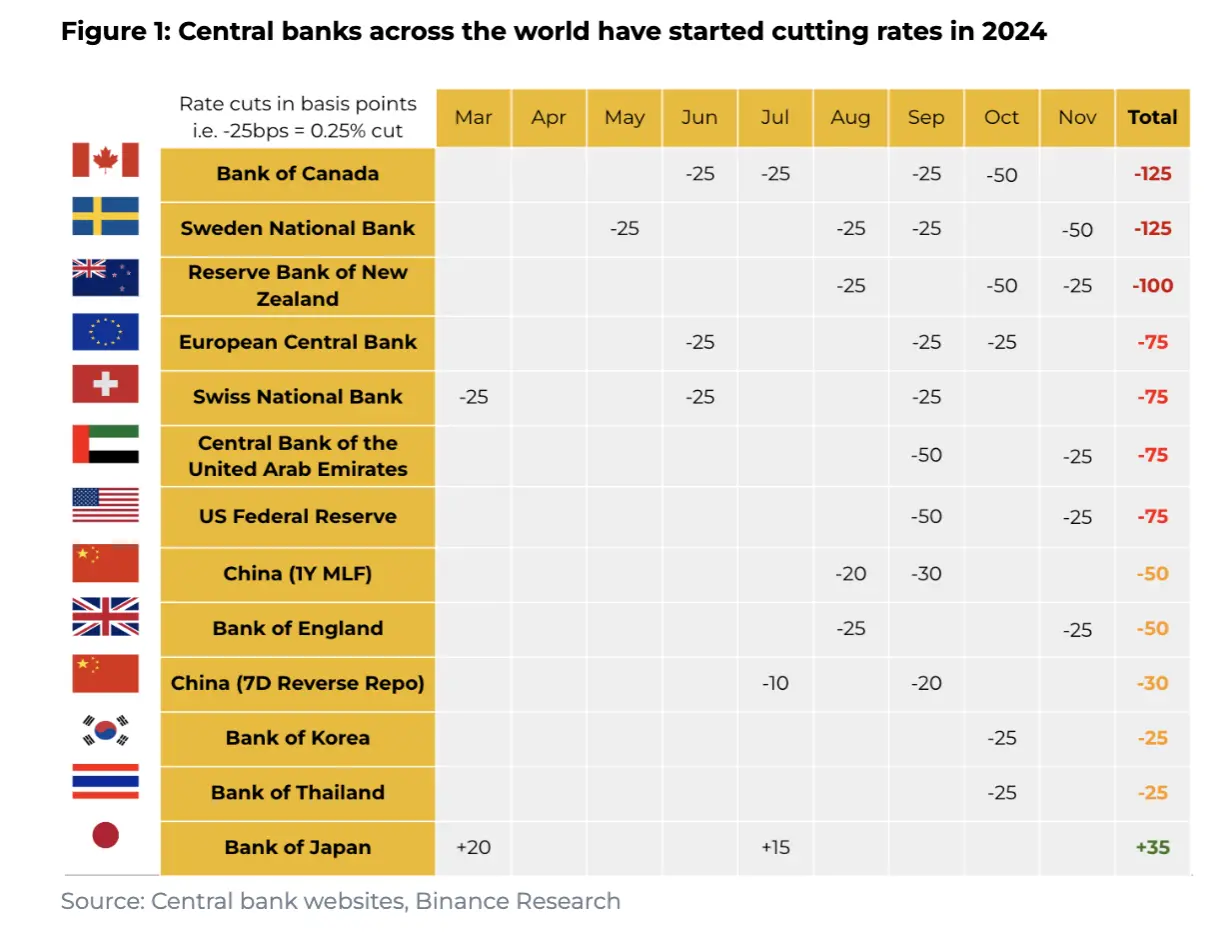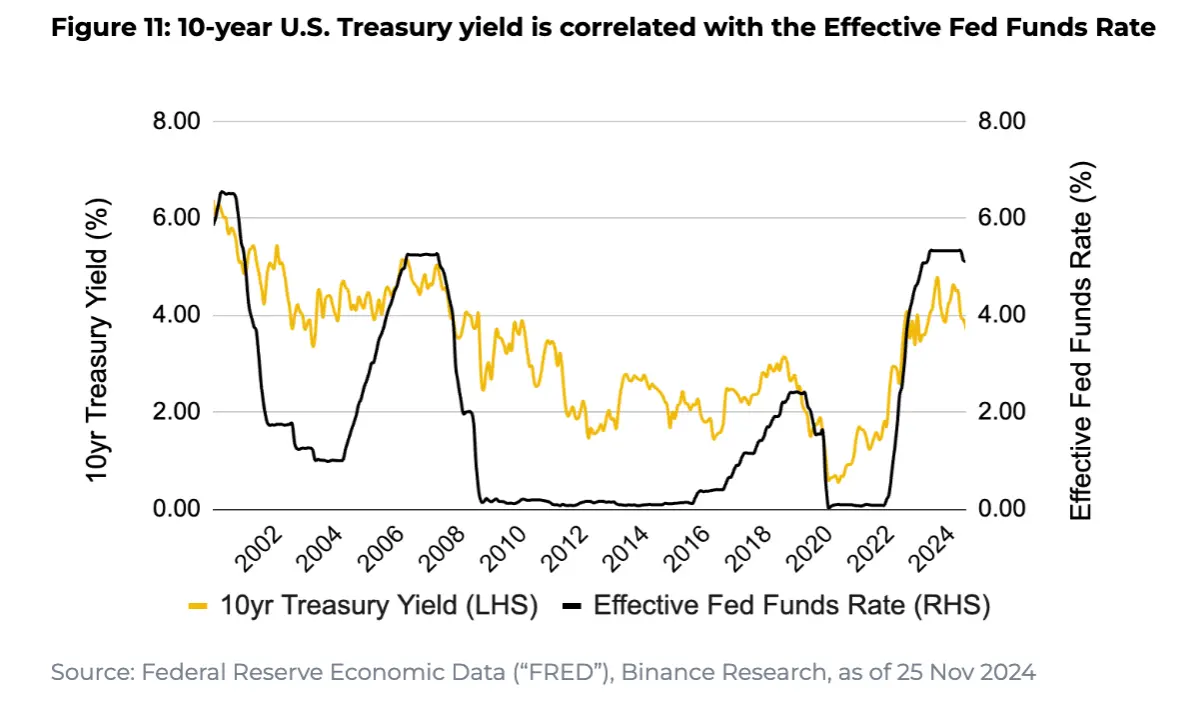A Comprehensive Analysis of the Binance Research Institute Report: The Arrival of the 2024 Rate Cut Cycle and the Impact of Federal Reserve Policies
Author: Deep Tide TechFlow
Introduction
In today's ever-changing global economic landscape, the direction of the Federal Reserve's monetary policy significantly impacts global financial markets. In September 2024, the Federal Reserve cut interest rates for the first time since 2020, marking the beginning of a new rate-cutting cycle.
Binance Research recently released a report that delves into the background of the Federal Reserve's interest rate policy and its effects on the economy and various asset classes.
The report systematically analyzes the relationships between core economic indicators such as interest rates, inflation, and employment, based on economic fundamentals, the latest data, and historical experience. It also provides a comprehensive analysis of the performance of different asset classes, including stocks, bonds, commodities, and cryptocurrencies during the rate-cutting cycle, offering clear decision-making references for investors.
Deep Tide TechFlow has summarized the key information from the report, as follows.

Key Points
• Latest Rate Cut Dynamics: The Federal Reserve announced a 0.5% rate cut in September 2024, followed by a further 0.25% cut in November, marking the first rate cut since the COVID-19 response measures in March 2020. The market expects a continued rate cut of 1-2 percentage points in 2025, with a probability of approximately 62% for another 0.25% cut in December.
Policy Background Analysis: The Federal Reserve adheres to the principle of a "dual mandate," aiming to promote maximum employment and maintain price stability (with an inflation target of 2%). In mid-2022, inflation briefly exceeded 9%, prompting the Federal Reserve to take aggressive rate-hiking measures, raising rates to the highest level in 20 years. As inflation gradually cools, the Federal Reserve has initiated a new rate-cutting cycle.
Interest Rate Impact Mechanism: As the "price of money," changes in interest rates will affect the market through two main channels:
Lowering borrowing costs, making it easier for market participants to access funds while reducing the burden of existing debt.
Lowering risk-free yields, prompting investors to seek alternative investment channels to enhance returns.
Historical Trends: U.S. interest rates have shown a structural decline over the past 50 years, dropping from 8-10% in the 1980s to near-zero levels in the 2010s, and recently rising above 5%.
Asset Performance Analysis:
The stock market (S&P 500) generally trends upward after rate cuts, though exceptions may occur during economic recessions.
The relationship between commodities and interest rates is complex, influenced by multiple factors such as inventory costs, lack of yields, and exchange rates.
Bond prices exhibit a clear inverse relationship with interest rates.
Although historical data for cryptocurrencies is limited, they have performed strongly during rate-cutting cycles, such as a 537% increase within 12 months following the March 2020 rate cut.
Policy Shift: The Global Central Bank Rate-Cutting Prelude Has Begun
On September 18, 2024, the Federal Reserve lowered the target range for the federal funds rate by 0.5 percentage points to 4.75-5.00%, marking the first rate cut since the COVID-19 response in March 2020. Prior to this, to combat rising inflation, the Federal Reserve had aggressively raised rates from March 2022 to July 2023, maintaining rates steady for eight consecutive meetings until this rate cut. The 0.25% cut in November further confirmed the initiation of a new rate-cutting cycle.
The Federal Reserve's policy actions consistently revolve around its dual mandate: promoting maximum employment and maintaining price stability. In the post-pandemic period, prices surged rapidly, with inflation exceeding 9% in mid-2022, prompting the Federal Reserve to initiate the strongest rate-hiking cycle in 20 years, raising the target rate from 0-0.25% during the pandemic to 5.25-5.50%. As inflation gradually cools, the Federal Reserve has begun to shift towards easing. Current market expectations suggest a potential rate cut of 1-1.5 percentage points in 2025, with a probability of approximately 62% for a 0.25% cut in December (and about 38% for rates to remain unchanged).
The relationship between inflation, rate cuts, and the broader economic system (including asset performance) is intricate and warrants close attention from market participants.
Notably, multiple central banks globally have initiated rate-cutting processes in 2024, a trend that will have profound implications for global financial markets.

Basic Concepts: Interest Rates and Economic Operation Mechanism
Warren Buffett once said, "Interest rates drive everything in the economic universe." Let's start from the most basic concepts to understand how interest rates affect economic operations.
Basic Principles of Interest Rates
• Core Definition: Interest rates are essentially the "price of money."
Higher interest rates = money becomes more expensive.
Lower interest rates = money becomes cheaper.
Two Major Impacts of the Current Rate-Cutting Environment
Debt and Borrowing Effects
Businesses and institutions can obtain financing at lower costs, promoting investment expansion.
The interest burden on existing debt decreases, improving cash flow conditions.
Consumer borrowing costs decline, stimulating consumption and housing demand.
Overall economic activity is boosted, aiding economic growth.
Yield Effect
The yields on risk-free assets like government bonds decline.
Investors are forced to seek alternative investment channels for higher returns.
Valuations of risk assets such as stocks and real estate are supported.
Funds shift from low-risk assets to high-risk assets.
Key Economic Variables
Inflation
The Federal Reserve has set a long-term target inflation rate of 2%.
Inflation briefly exceeded 9% in mid-2022.
Employment Situation
The current unemployment rate remains at a relatively healthy level of 4.1%.
Non-farm payroll data is released on the first Friday of each month and is an important market indicator.
Market Environment and External Factors

Corporate Earnings: Quarterly earnings reports and expectations serve as a barometer of market confidence.
Regulatory Policies: The regulatory stance on financial innovations, including cryptocurrencies (as shown in the chart below, where green represents a significant increase in the number of crypto-friendly individuals in the U.S. House and Senate during elections).
Geopolitics: External shocks such as international trade relations and regional conflicts.
Macroeconomic Indicators: Including trade balance, consumer confidence, PMI, etc.
Historical Perspective: Past Federal Reserve Rate-Cutting Cycles and Asset Performance
Interest Rate Change Trends
Over the past 50 years, U.S. interest rates have shown a structural decline:
1980s: Maintained at high levels of 8-10%.
2010s: Approached near-zero interest rates.
Recent: Rose above 5%.
September and November 2024: Initiated a new rate-cutting cycle.

Historical Performance of Various Assets
- Stock Market (S&P 500)
- Overall Trend: Generally rises after rate cuts.

Specific Performance:

September 1984 first rate cut: +1% in 3 months, +9% in 6 months, +14% in 12 months.
July 1995 rate cut: +6% in 3 months, +13% in 6 months, +22% in 12 months.
Special Cases: Negative returns during economic recession periods in 2001 and 2007.
January 2001: -12% in 12 months.
September 2007: -18% in 12 months.
- Commodities
Influencing Factors:
Inventory Costs: Interest rates affect holding costs.
Yield Characteristics: No fixed yield.
U.S. Dollar Exchange Rate: Commodities are often priced in dollars.
Inflation Association:

Often viewed as a leading indicator of inflation.
Commonly used as an inflation hedge.
- Bonds
- Core Characteristics: Exhibit a clear inverse relationship with interest rates.

Operational Mechanism:
Rising interest rates → bond prices fall.
Falling interest rates → bond prices rise.
Ten-Year Treasury Yield: Highly correlated with the federal funds rate.
- Cryptocurrencies
Historical Data: Only experienced two rate-cutting cycles (second half of 2019 and March 2020).
Performance Highlights:
July 2019 rate cut: +25% in 12 months.
March 2020 rate cut: +537% in 12 months.
Special Considerations:
Short sample period.
Relatively small market size with high volatility.
Influenced by multiple factors, not limited to interest rate changes.

This historical review shows that while rate cuts typically support asset prices, specific performances vary by asset class and macroeconomic environment. Particularly during economic recessions, even rate cuts may not prevent asset prices from declining, indicating that investors need to consider multiple factors rather than simply relying on rate cuts for investment decisions.

Conclusion: The Global Rate-Cutting Cycle Has Begun, with Opportunities and Challenges in the Market
As the report indicates, September 2024 became the fourth largest rate-cut month of this century, with 26 central banks globally implementing rate cuts. This trend continued into October and November, marking the entry of global monetary policy into a new cycle. As the most influential central bank in the world, the Federal Reserve's rate cuts in September and November not only have far-reaching implications but also signal a potential for broader policy easing in 2025.
Historically, rate-cutting cycles often reduce the cost of money, improve market liquidity, and subsequently support asset prices. However, this round of rate cuts is unique: global inflation has significantly retreated from its peak in 2022, but the risk of inflation rebound remains; the job market remains relatively stable, with the unemployment rate at a healthy level of 4.1%; and geopolitical situations add additional uncertainty.
Looking ahead to 2025, the market generally expects the Federal Reserve to continue cutting rates by 1-1.5 percentage points. Against this backdrop, major global central banks may follow the Federal Reserve's lead to further improve liquidity conditions. However, while seizing opportunities, investors also need to remain clear-headed: different asset classes may exhibit differentiated performances during rate-cutting cycles, and simply following rate cuts may not yield ideal returns. It is recommended that investors focus on structural opportunities and exercise caution in their allocations to better navigate this new market environment.








